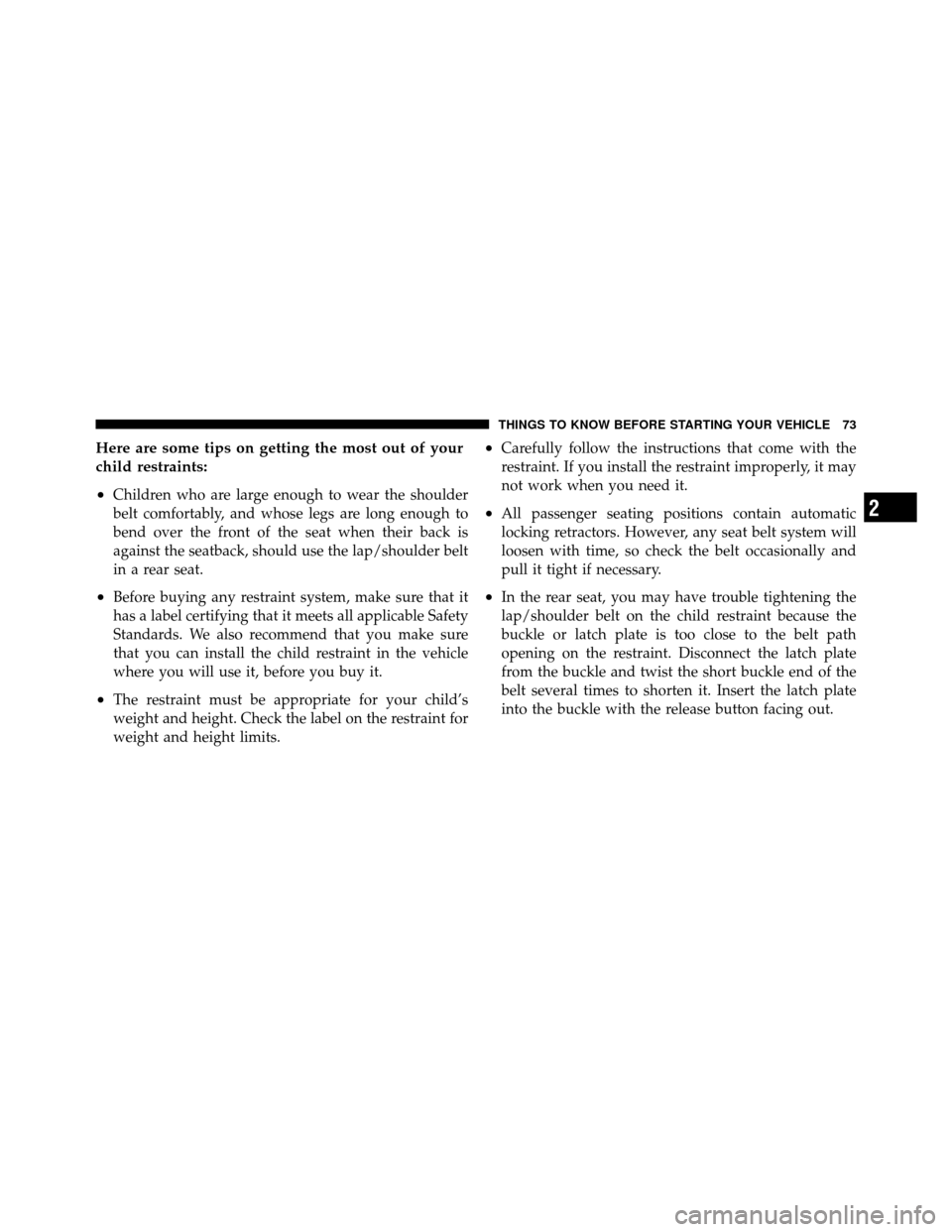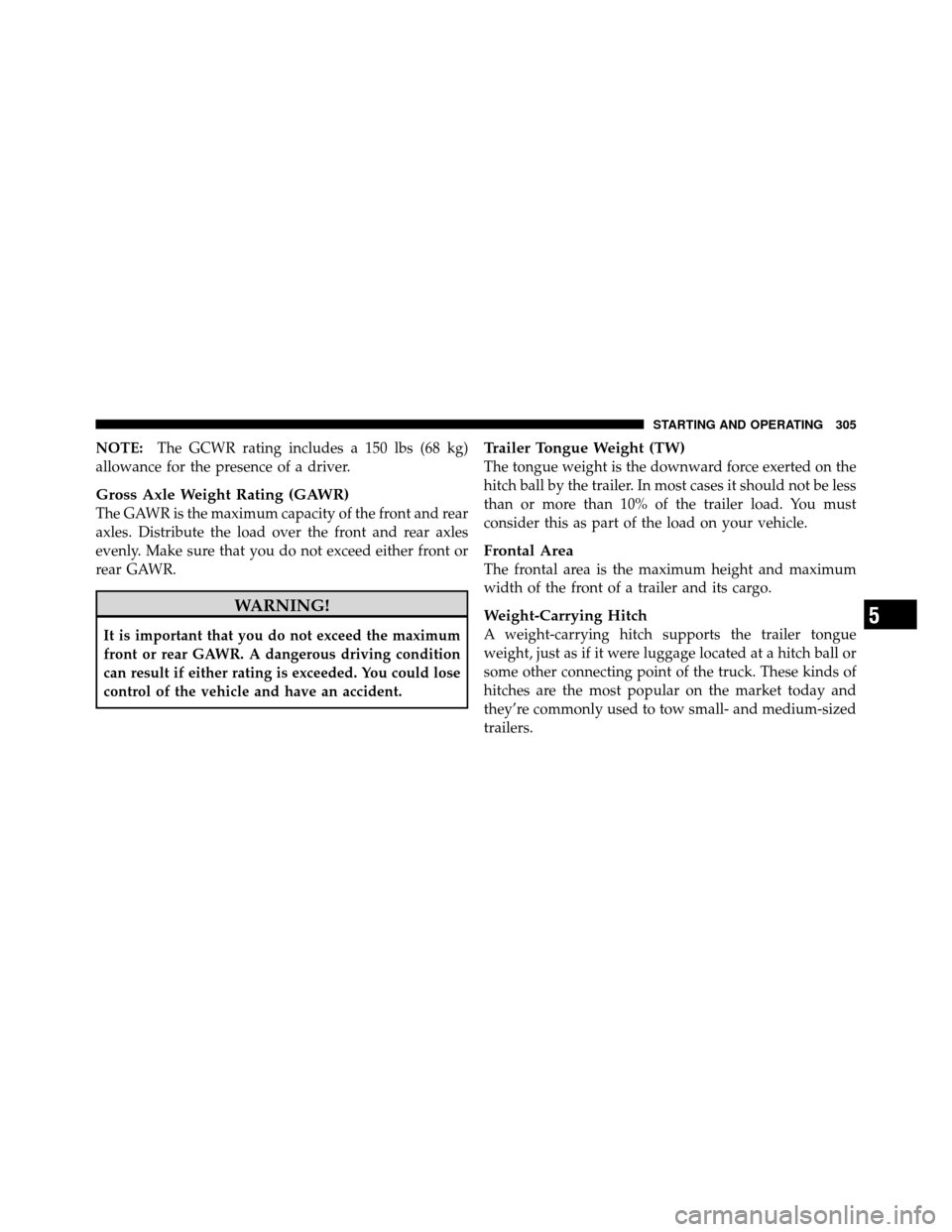Page 73 of 436

Here are some tips on getting the most out of your
child restraints:
•
Children who are large enough to wear the shoulder
belt comfortably, and whose legs are long enough to
bend over the front of the seat when their back is
against the seatback, should use the lap/shoulder belt
in a rear seat.
•Before buying any restraint system, make sure that it
has a label certifying that it meets all applicable Safety
Standards. We also recommend that you make sure
that you can install the child restraint in the vehicle
where you will use it, before you buy it.
•The restraint must be appropriate for your child’s
weight and height. Check the label on the restraint for
weight and height limits.
•Carefully follow the instructions that come with the
restraint. If you install the restraint improperly, it may
not work when you need it.
•All passenger seating positions contain automatic
locking retractors. However, any seat belt system will
loosen with time, so check the belt occasionally and
pull it tight if necessary.
•In the rear seat, you may have trouble tightening the
lap/shoulder belt on the child restraint because the
buckle or latch plate is too close to the belt path
opening on the restraint. Disconnect the latch plate
from the buckle and twist the short buckle end of the
belt several times to shorten it. Insert the latch plate
into the buckle with the release button facing out.
2
THINGS TO KNOW BEFORE STARTING YOUR VEHICLE 73
Page 85 of 436
UNDERSTANDING THE FEATURES OF YOUR VEHICLE
CONTENTS
�Mirrors .............................. 89
▫ Inside Day/Night Mirror ................ 89
▫ Automatic Dimming Mirror — If Equipped . . . 90
▫ Power Mirrors ....................... 90
▫ Adjusting Sideview Mirrors .............. 92
▫ Illuminated Vanity Mirrors — If Equipped . . . 93
� uconnect™ phone — If Equipped ........... 93
� Voice Recognition (VR) System — If Equipped . . 93
� Seats ............................... 94 ▫
Manual Front Seat Adjustment ............ 94
▫ Driver Seat Manual Height Adjuster —
If Equipped ......................... 95
▫ Reclining Bucket Seats .................. 96
▫ Lumbar Support — If Equipped ........... 97
▫ Power Seats — If Equipped .............. 97
▫ Adjusting Active Head Restraints .......... 98
▫ Heated Seats — If Equipped ............ 101
▫ Fold-Flat Passenger Seatback ............ 102
3
Page 95 of 436
WARNING!
Adjusting a seat while the vehicle is moving is
dangerous. The sudden movement of the seat could
cause you to lose control. The seat belt might not be
properly adjusted and you could be injured. Adjust
the seat only while the vehicle is parked.
Driver Seat Manual Height Adjuster — If
Equipped
A lever style height adjustment feature enhances comfort
for petite as well as tall drivers. A lever with a ratcheting
mechanism, located on the outboard side of the seat,
raises and lowers it. Total travel is 2.2 in (56 mm).
Manual Seat Height Adjustment Lever
3
UNDERSTANDING THE FEATURES OF YOUR VEHICLE 95
Page 265 of 436
•High flotation tire sizing is based on U.S. design
standards and it begins with the tire diameter molded
into the sidewall. Example: 31x10.5 R15 LT.
Tire Sizing Chart
EXAMPLE:
Size Designation:
P= Passenger car tire size based on U.S. design standards
�....blank....� = Passenger car tire based on European design standards
LT = Light truck tire based on U.S. design standards
T = Temporary spare tire
31 = Overall diameter in inches (in)
215 = Section width in millimeters (mm)
65 = Aspect ratio in percent (%)
— Ratio of section height to section width of tire
10.5 = Section width in inches (in)
R = Construction code
—�R� means radial construction
—�D� means diagonal or bias construction
15 = Rim diameter in inches (in)
5
STARTING AND OPERATING 265
Page 305 of 436

NOTE:The GCWR rating includes a 150 lbs (68 kg)
allowance for the presence of a driver.
Gross Axle Weight Rating (GAWR)
The GAWR is the maximum capacity of the front and rear
axles. Distribute the load over the front and rear axles
evenly. Make sure that you do not exceed either front or
rear GAWR.
WARNING!
It is important that you do not exceed the maximum
front or rear GAWR. A dangerous driving condition
can result if either rating is exceeded. You could lose
control of the vehicle and have an accident.
Trailer Tongue Weight (TW)
The tongue weight is the downward force exerted on the
hitch ball by the trailer. In most cases it should not be less
than or more than 10% of the trailer load. You must
consider this as part of the load on your vehicle.
Frontal Area
The frontal area is the maximum height and maximum
width of the front of a trailer and its cargo.
Weight-Carrying Hitch
A weight-carrying hitch supports the trailer tongue
weight, just as if it were luggage located at a hitch ball or
some other connecting point of the truck. These kinds of
hitches are the most popular on the market today and
they’re commonly used to tow small- and medium-sized
trailers.
5
STARTING AND OPERATING 305